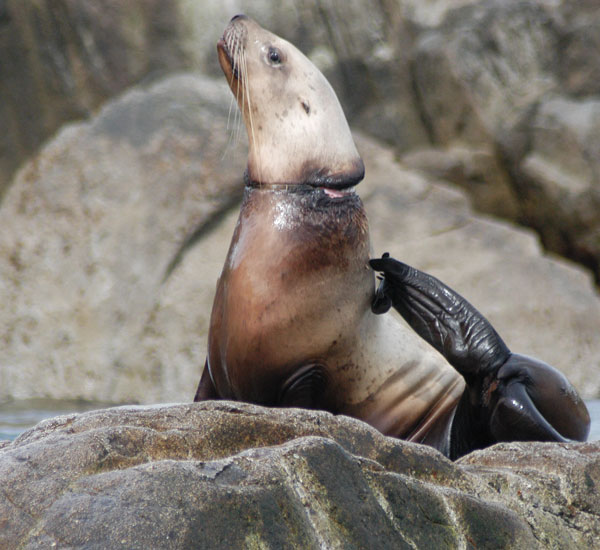Video Reveals Shocking Footage of Sea Lions Strangled by Debris

The images aren't pretty: Sea lions with shiny fishing lures protruding from their mouths or with their necks tightly bound, even deeply cut, by packing bands once used to secure boxes. Seals with necks tightly encircled by pieces of fishing net.
The scientists who study these animals know that becoming entangled with items such as these can injure or even kill the unlucky animals.
A video, put together by the Alaska Department of Fish and Game, documents the effects of loops, fishing gear and other debris, including a tire and a wind sock — which drowned a sea lion by pinning her flippers to her body. [See video of entangled sea lions]
The researchers posted the video on YouTube recently to let people know about the problem.
The problems
A study of eastern Steller sea lions, which are threatened by extinction, along the southeastern coast of Alaska and northern British Columbia found that plastic packing bands and rubber bands were the most common items to show up around the animal's necks, while metal flasher lures used for salmon fishing were the most frequently ingested fishing gear.
Between 2000 and 2007, the study researchers spotted 386 animals that had picked up some sort of debris.
Get the world’s most fascinating discoveries delivered straight to your inbox.
"We are certainly underestimating the number of animals entangled. We go out every summer here in southeastern Alaska and we try to visit every haul out (where animals come to shore) and rookery (where they breed) at least once," said study researcher Lauri Jemison, a wildlife biologist in the Steller Sea Lion program of the Alaska Department of Fish and Game.
Their numbers are likely conservative, as they could've missed counting an entangled sea lion that didn't come to shore, wasn't visible in the crowd of sea lions or that hauled out elsewhere, Jemison said.
A widespread problem
Many marine species, including marine mammals, sea birds and turtles, face similar problems, Jemison and colleagues write in the journal Marine Pollution Bulletin in 2009.
In Alaskan waters, Steller sea lions and the smaller, northern fur seals become entangled more frequently than other pinnipeds (fin-footed mammals).
Fur seals, too, somehow manage to pick up bands around their necks, like the sea lions do. But unlike Steller sea lions, they don't appear to be swallowing much fishing gear, according to Michael Williams, the Pribilof Island program manager for the National Marine Fisheries Service.
During intensive surveys on the Pribilof Islands, in the Bering Sea off the coast of Alaska, researchers could spot about 100 entangled fur seals from a population of about 500,000 that use the islands as a home base during the summer and fall, according to Williams. But, as with the sea lions, it's quite likely more animals are affected.
Getting caught
Somehow, fur seals, and probably sea lions as well, swimming out in the great blue ocean are finding their way through little loops, according to Williams.
"The probability of it seems so remote given how big the ocean is, yet it still happens. I think it has to do with convergence zones." Ocean debris collects in these zones where currents converge forming islands of debris, which attract fish seeking shelter, and in turn, their predators, including seals, Williams speculates. [Album: Lost Predators Leave Broken Food Chains]
While adults may pick the loops up during foraging, young pups may become entangled while playing. As young seals — which appear more prone to become entangled — grow, the restriction around their necks tightens, potentially strangling them. This is especially true of males, which develop larger, thicker necks, and grow larger overall than females, according to Jemison.
Preventing entanglements
There are a number of ways to address the problem. The "Lose the Loop" slogan encourages people to simply cut any loop that could be thrown into the trash or modify gear so it doesn't contain loops. However, the cut bands can still create problems if they are ingested by animals, note the authors of the Marine Pollution Bulletin.
Other solutions include reducing litter from boats and on land, and using materials that don't need loops, according to experts.
Educating the fishing industry is another key. Sea lions often pick up fishing lures while chasing an easy meal, according to Jemison, who said that both commercial and casual fishermen lose salmon and their lures, lines and hooks to hungry sea lions.
Hooks can perforate a sea lion's esophagus or stomach, killing the animal. Sometimes a dangling lure is a sign of a swallowed hook, and sometimes there is no external sign the animal has consumed fishing gear. (By itself, a lure is not a death sentence, as some animals lose the shiny flashing lures and continue with their lives.)
The department is currently seeking funding to work with the fishing industry to come up with solutions, such as modified gear or deterrents to keep the sea lions away from fishing boats, she said.
You can follow LiveScience senior writer Wynne Parry on Twitter @Wynne_Parry. Follow LiveScience for the latest in science news and discoveries on Twitter @livescience and on Facebook.





